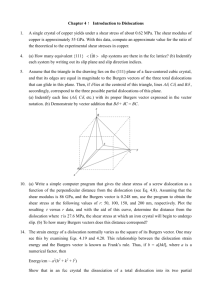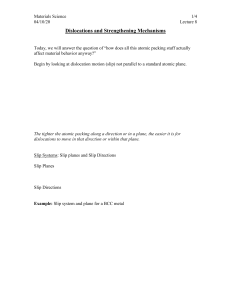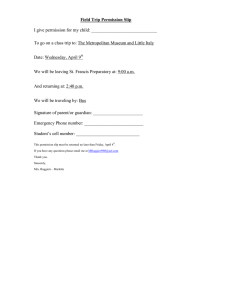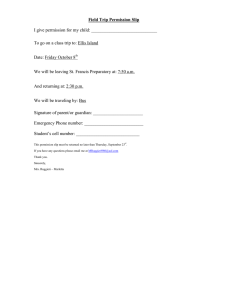Material Deformations
advertisement
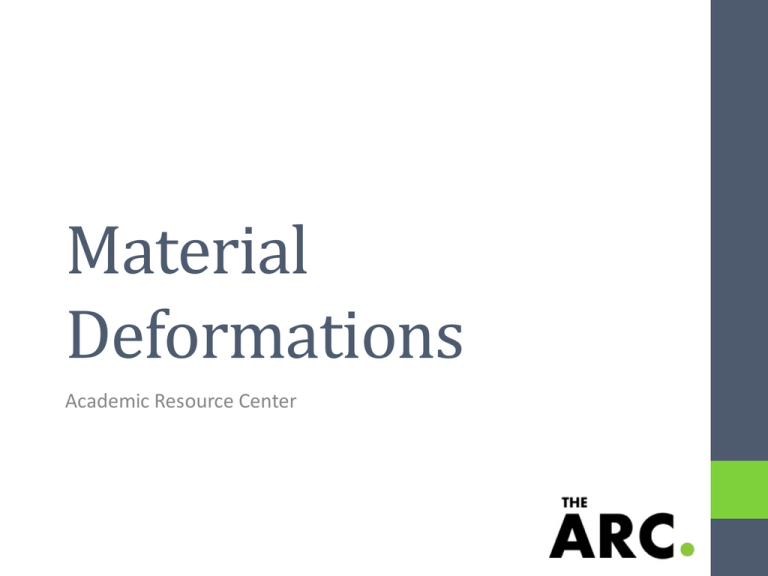
Material
Deformations
Academic Resource Center
Agenda
•
•
•
•
•
•
Origin of deformations
Deformations & dislocations
Dislocation motion
Slip systems
Stresses involved with deformation
Deformation by twinning
Origin of Deformations
• Theoretical strengths of perfect crystal were much higher than those
actually measured.
• It was determined that this discrepancy in mechanical strength could
be explained by dislocations.
• On a macroscopic scale, plastic deformation corresponds to the net
movement of large numbers of atoms in response to an applied
stress.
Edge and Screw Dislocations
• In an edge dislocation, localized lattice distortion exists along the
end of an extra half-plane of atoms.
• A screw dislocation results from shear distortion.
• Many dislocations in crystalline materials have both edge and
screws components; these are mixed dislocations.
Direction of Dislocation Motion
Edge dislocation line moves parallel to applied stress
Screw dislocation line moves perpendicular to applied stress
5
Dislocation Motion
• Dislocation motion leads to plastic deformation.
Dislocation Motion
• An edge dislocation moves in response to a shear
stress applied in a direction perpendicular to its line.
• Extra half-plane at A is forced to the right; this
pushes the top halves of planes B, C, D in the same
direction.
• By discrete steps, the extra 1/2-plane moves from L
to R by successive breaking of bonds and shifting of
upper 1/2-planes.
• A step forms on the surface of the crystal as the
extra 1/2-plane exits.
Formation
of a step on
the surface
of a crystal
by the
motion of
(a) edge
dislocation
and (b)
screw
dislocation.
Slip
• The process by which plastic deformation is produced by dislocation
motion is called slip (movement of dislocations).
• The extra 1/2-plane moves along the slip plane.
• Dislocation movement is similar to the way a caterpillar moves. The
caterpillar hump is representative of the extra ½-plane of atoms.
When metals are plastically deformed, some fraction (roughly
5%) of energy is retained internally; the remainder is dissipated
as heat. Mainly, this energy is stored as strain energy associated
with dislocations. Lattice distortions exist around the dislocation
line.
Slip Systems
• Dislocations move more easily on specific planes and in specific
directions.
• Ordinarily, there is a preferred plane (slip plane), and specific
directions (slip direction) along which dislocations move.
• The combination of slip plane and slip direction is called the slip
system.
Slip Systems
• The slip system depends on the crystal structure of the metal.
• The slip plane is the plane that has the most dense atomic
packing (the greatest planar density).
• The slip direction is most closely packed with atoms (highest
linear density).
Slip System – FCC example
Slip Plane {111}:
most dense atomic packing,
‹ ›
Slip Direction 110 (pink arrows):
highest linear density,
Stress and Dislocation Motion
• Edge and screw dislocations move in response to shear stresses
applied along a slip plane in a slip direction.
• Even though an applied stress may be tensile, shear components exist
in directions other than the ones parallel or perpendicular to the stress
direction.
• These are called resolved shear stresses (tR).
Resolved Shear Stress, tR
Critical Resolved Shear Stress
• In response to an applied tensile or compressive stress, slip in a single
crystal begins when the resolved shear stress reaches some critical value,
tcrss.
• It represents the minimum shear stress required to initiate slip and is a
property of the material that determines when yielding occurs.
y
t crss
(cos cos ) max
Deformation in a single crystal
• For a single crystal in tension,
slip will occur along a number
of equivalent & most favorably
oriented planes and directions
at various positions along the
specimen.
• Each step results from the
movement of a large number
of dislocations along the same
slip plane.
Dislocation Motion in Polycrystals
•On the surface of a polished
single crystal, these steps
appear as lines (slip lines).
•Slip planes & directions
change from one crystal to
another.
•tR will vary from one crystal to
another.
•The crystal with the largest tR
yields first.
Deformation by Twinning
• In addition to slip, plastic deformation can occur by
twinning.
• A shear force can produce atomic displacements so that
on one side of the plane (the twin boundary), atoms are
located in mirror image positions to atoms on the other
side.
References
• Abbaschian, Reed-Hill. “Physical Metallurgy Principles”. 4th edition.
2009
• Beer & Johnston (2006). Mechanics of Materials (5th edition).
McGraw Hill.
